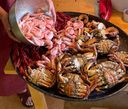Rock Crabs
Cancridae
Classification
- Phylum: Arthropoda
- Subphylum: Crustacea
- Class: Malacostraca
- Superorder: Eucarida
- Order: Decapoda
- Infraorder: Brachyura
- Family: Cancridae
Pronunciation
How to pronounce Cancridae: /ˈkæŋkrɪˌdeɪ/
These audio files are automatically generated. While they are not always 100% accurate, they are a good starting point.
Images






Summary
Cancridae is a diverse family of crabs primarily found in temperate waters, with a rich fossil history and significant ecological and economic roles in their habitats.
Physical Characteristics
Rock crabs have a robust body with a broad carapace and large claws. Their body coloration varies, providing camouflage against rocky substrates.
Identification Tips
Look for a broad carapace, pronounced claws, and a generally stout body. Species can often be identified by their size and the shape of their claws and carapace.
Habitat
Rock crabs are commonly found in intertidal zones and rocky shorelines, where they inhabit crevices and under boulders.
Distribution
Primarily found in temperate waters of the Northern Hemisphere.
Diet
Rock crabs are omnivorous, feeding on mollusks, crustaceans, and detritus found in their habitat.
Life Cycle
Rock crabs have a complex life cycle that includes several larval stages known as zoea and megalops before reaching adulthood.
Reproduction
Most rock crabs reproduce in the summer months, with females carrying fertilized eggs under their abdomen until they hatch.
Predators
Common predators include fish, sea otters, and larger crustaceans.
Ecosystem Role
As both predator and prey, rock crabs play a significant role in marine ecosystems, helping to control populations of their prey and serving as food for larger animals.
Economic Impact
Rock crabs are of commercial importance and are harvested for food in many regions, particularly in the fisheries of the Northern Hemisphere.
Collecting Methods
- Hand catching
- Traps
Preservation Methods
- Freezing
- Pickling
Evolution
The family Cancridae has a rich fossil record, with many extinct genera indicating a long evolutionary history spanning millions of years.
Similar Taxa
Misconceptions
Some people may confuse rock crabs with other crab species, leading to errors in identification.
Tags
- Rock Crabs
- Crustacea
- Marine Biology
- Ecology